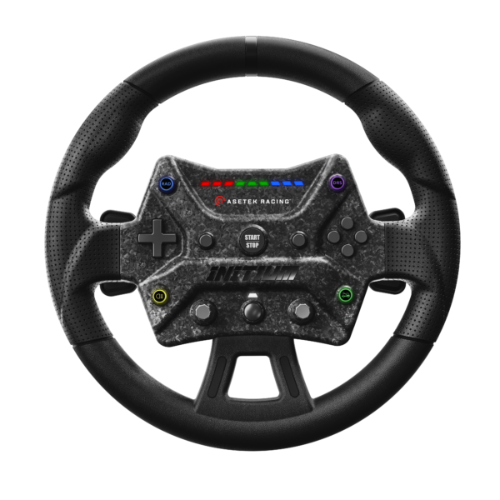Sim Racing Wheels
A sim racing wheel is the centerpiece of any racing setup. Unlike a gamepad or keyboard, a wheel provides the realism, control, and immersion that sim racing is built upon. A complete wheel includes the rim, integrated buttons, paddles, and a quick-release mechanism. Many modern wheels also feature displays, LED rev lights, and rotary encoders for in-race adjustments. Choosing the right wheel ensures that your setup not only feels authentic but also performs to your expectations.
What Is a Sim Racing Wheel?
A sim racing wheel is a complete steering device designed to mount onto a wheel base. It combines the physical rim with electronics such as buttons, rotary encoders, and paddle shifters. Many wheels also use quick-release systems that allow easy swapping between different models. This makes them distinct from rims, which are only the circular frame and require additional components to be functional. A sim racing wheel replicates real-world steering devices and adapts them for racing disciplines ranging from GT to Formula.
Why the Right Wheel Matters
The right wheel does more than look the part – it directly affects how you drive. A well-matched wheel provides comfort, precise control, and features that suit your preferred racing style. A Formula-style wheel, for example, allows quick access to multiple buttons and encoders, while a rally wheel prioritizes diameter and grip for smoother handling. Wheels with high-quality materials and ergonomics reduce strain during long stints, while smart layouts improve consistency and immersion.
Types of Sim Racing Wheels
Not all wheels serve the same purpose. Different motorsport disciplines require different wheel shapes, sizes, and controls. Choosing the right type ensures that your setup feels authentic and performs as intended.
GT Wheels
GT wheels are round or slightly D-shaped, designed to replicate modern sports cars and touring vehicles. Their versatile size and balanced button layouts make them a strong choice for endurance racing or mixed driving styles.
Formula Wheels
Formula wheels feature a compact, flat-bottom design with wide grips. They typically include multiple buttons, paddles, and rotary encoders for on-the-fly adjustments. These wheels excel in open-wheel racing where quick, precise inputs are crucial.
Rally / Drift Wheels
Rally and drift wheels are larger in diameter, allowing smoother and more precise steering control. Their layouts are often simpler, with fewer buttons and a focus on grip and handling. They are ideal for disciplines where steering accuracy outweighs quick access to multiple controls.
Classic Wheels
Classic wheels emulate vintage racing designs. They often use minimalist layouts with few electronics, prioritizing authenticity and driving feel over advanced features. These wheels suit enthusiasts who enjoy historic cars and classic racing experiences.
Key Factors to Consider
Selecting a wheel means balancing realism, comfort, and compatibility. Several factors help determine which model fits your needs best.
Size and Shape
The diameter and shape of a wheel impact how it feels in different disciplines. Smaller wheels provide faster response, while larger wheels give smoother, more precise control.
Materials and Grip
Leather, Alcantara, and rubber each offer different sensations and durability. Your choice influences grip comfort and how well the wheel holds up over time.
Controls and Features
Integrated buttons, rotary encoders, and paddles improve accessibility. Some advanced wheels also include rev LEDs, clutch paddles, or small displays for telemetry and race data.
Quick-Release Systems
Quick-release systems allow you to swap wheels without tools. Each brand has its own design, which is often locked to their ecosystem.
Ecosystem Compatibility
Wheels are usually brand-specific. Fanatec wheels work on Fanatec bases, Thrustmaster wheels on Thrustmaster bases, and so on. High-end brands sometimes support universal quick-release standards, while adapters exist for cross-compatibility. However, these may reduce official support.
Popular Brands
The sim racing wheel market includes several trusted names. Each brand has its own strengths and approach to design. Fanatec offers a strong ecosystem with options from beginner wheels to advanced competition-grade units. Thrustmaster provides a wide range of affordable and mid-tier wheels, balancing accessibility with variety. Logitech appeals to beginners with simple, durable wheels that are easy to use. High-end brands like Cube Controls and Ascher Racing deliver premium materials, advanced electronics, and outstanding ergonomics. Simagic also stands out with modular quick-release systems that make wheel swapping fast and seamless.
Recommendations by Driving Style
Different wheels suit different racing disciplines. GT racing benefits from round or D-shaped wheels with a moderate button layout. Formula racing demands compact wheels with multiple encoders and paddles for precise control. Rally and drift require larger wheels that emphasize handling and smooth steering. Vintage racing is best experienced with classic designs that prioritize authenticity over modern electronics. Matching your wheel to your driving style ensures maximum immersion and comfort.
Key Takeaways
A sim racing wheel is a complete steering device that combines rim, electronics, and connection systems. Choosing the right one depends on your preferred racing discipline, comfort needs, and brand ecosystem. Options range from versatile GT wheels to advanced Formula designs, rally-focused setups, and classic replicas. The correct choice enhances immersion, reduces fatigue, and improves control.
